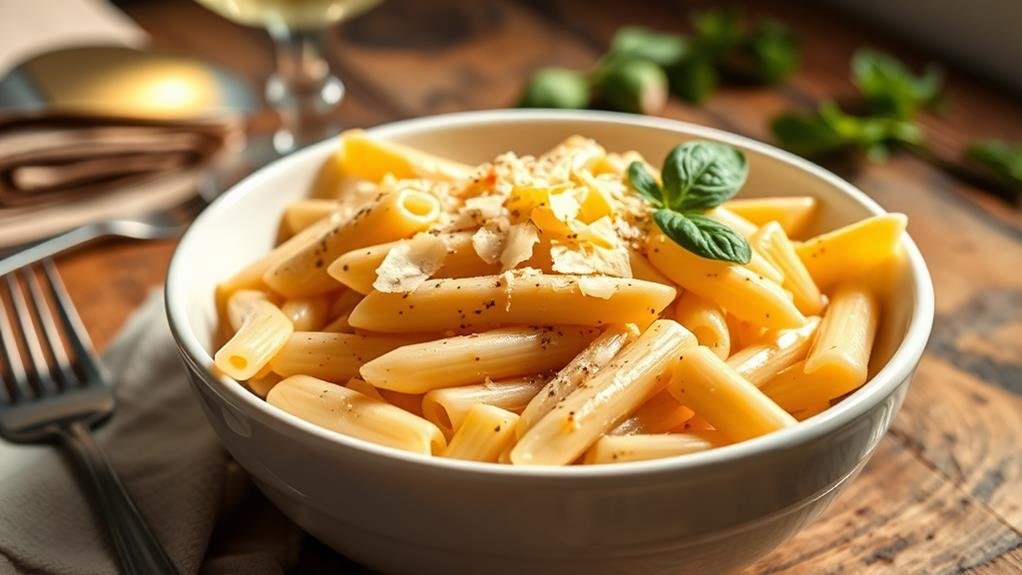Nothing beats a good four-cheese pasta, and this Cheesecake Factory copycat hits all the right spots. After years of tinkering in my kitchen, I've cracked their code – and it's simpler than you'd think.
Start with good pasta – penne works best because those little ridges grab onto the sauce like nobody's business. For the cheese blend, you'll want equal parts sharp provolone, asiago, parmesan, and romano. Trust me, pre-grated won't cut it here – grab a block of each and grate them fresh.
The trick to getting that silky sauce just right? Take it slow. Start with a butter and flour roux, add warm milk (not cold!), and keep stirring until it thickens up nicely. When you add the cheese, turn the heat down low – rushing this part will leave you with a grainy mess.
Mix your cooked pasta right into the sauce while it's still piping hot. Give it a good stir and let it sit for a minute or two – the pasta will drink up some of that sauce and taste even better.
Sounds fancy, but really it's just good ingredients treated right. Makes enough for six hungry folks, or eight regular portions. Leftovers heat up surprisingly well – just add a splash of milk when rewarming.
Simple food done right – that's all there is to it.
Recipe

Four Cheese Pasta is a sumptuously creamy and indulgent dish that combines the rich flavors of multiple Italian cheeses with perfectly cooked pasta. This beloved comfort food has become a staple in many restaurants, and creating it at home allows you to adjust the cheese combinations to your preference while enjoying restaurant-quality results. This dish is reminiscent of other favorite pasta salads, like the Blt Pasta Salad With Chicken, which offers a unique twist on classic flavors.
This copycat recipe captures the essence of the classic four-cheese pasta found in popular Italian-American restaurants. The key to achieving the perfect consistency lies in selecting high-grade cheeses and creating a smooth, velvety sauce that coats each strand of pasta evenly.
- 1 pound penne pasta
- 8 oz mozzarella cheese, shredded
- 6 oz parmesan cheese, freshly grated
- 4 oz romano cheese, grated
- 4 oz fontina cheese, shredded
- 2 cups heavy cream
- 4 tablespoons butter
- 3 cloves garlic, minced
- 1/2 teaspoon black pepper
- 1/2 teaspoon salt
- 1/4 teaspoon nutmeg
Cook pasta in salted water according to package directions until al dente.
Meanwhile, in a large saucepan, melt butter over medium heat and sauté garlic until fragrant. Add heavy cream and bring to a gentle simmer. Gradually stir in all cheeses until melted and smooth. Season with salt, pepper, and nutmeg.
Drain pasta, reserving 1/2 cup pasta water, and add to the cheese sauce. Stir until well combined, adding pasta water if needed to reach desired consistency.
For best results, avoid pre-shredded cheese as it contains anti-caking agents that can prevent smooth melting. The sauce will continue to thicken as it cools, so serve immediately for top-notch texture. If reheating leftovers, add a splash of cream or milk to restore the original creamy consistency. This dish pairs well with garlic bread and a simple green salad.
Tucked away in countless Italian-American restaurants, four cheese pasta stands as a tribute to the simple yet profound combination of melted cheeses and perfectly cooked pasta.
This copycat version recreates the rich, creamy dish that has become a restaurant favorite, featuring a harmonious blend of Parmesan, mozzarella, Romano, and fontina cheeses.
While traditional Italian cuisine often focuses on using one or two cheeses in pasta dishes, this American adaptation embraces abundance, creating a luxurious sauce that clings to every strand of pasta.
The dish gained popularity in the 1980s alongside other Italian-American classics and continues to be a sought-after comfort food staple.
Conclusion
This old Cheesecake Factory favorite isn't nearly as fancy as it sounds. Take it from someone who's made this pasta more times than I can count – it's just good, honest cooking. You'll need four different cheeses (no shortcuts here), but don't worry about being too precise. Mix them up in a nice, creamy sauce, and you've got something that tastes just like the restaurant version. The trick is to cook everything slowly, letting those cheeses melt together properly. I always tell folks not to rush this part – good sauce takes patience, just like my mother used to say. And remember, when the pasta's done, give it a minute to sit and thicken up. The sauce might look a bit thin at first, but it'll come together nicely. Works every time, plain and simple.

